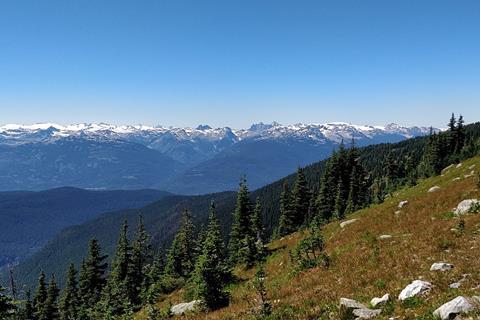The treeline ecotone serves crucial ecological functions such as maintaining biodiversity and supplying nutrients to downstream areas. The upward shift of the alpine treeline driven by global climate change has been extensively observed across many mountain ecosystems worldwide.
Knowledge of variations in belowground microbial communities in the treeline ecotone, as well as the influence of microtopographic factors (e.g., slope aspect) on these changes will be essential to understand how microbial communities in the treeline transition zones of alpine ecosystems respond to global warming and their potential effects on soil carbon dynamics.

A new study revealed distinct community characteristics, co-occurrence patterns, and assembly processes between bacterial and fungal communities. The results uncovered that microbial communities responded greatly to treeline shift than slope aspect, and also imply that the upward shift of the alpine treeline may increase the stochasticity of microbial communities. The findings of this study are published in Soil Ecology Letters.
A series of studies on the geographical distribution pattern of soil microbial communities have been conducted by Yuan Ge’s team at the Research Center for Eco-Environmental Sciences, Chinese Academy of Sciences, and many interesting findings have been obtained. For example, they found higher soil nutrients, archaeal and metazoan richness, and microbial functions at the treeline elevation, indicating a strong edge effect of treeline on microbial diversity and functions.
They also found consistent elevational patterns in bacterial alpha diversity and microbial functions (i.e., multifunctionality) across both slope directions. However, variations in belowground microbial communities in the treeline ecotone and the influence of microtopographic factors (e.g., slope aspect) on these changes are not well understood.
Microbial distribution in treeline ecotone
Professor Ge said, “The Qinghai-Tibet Plateau has the highest natural treeline in the Northern Hemisphere. We chose to study the Sygera Mountain located in southeastern of the Qinghai-Tibet Plateau, which has been observed experiencing an upward shift in the treeline over the past century due to the changing climate conditions. Therefore, the Sygera Mountain provides a proper and high-quality platform for microbial distribution studies in the treeline ecotone.”
In this study, they found that oligotrophic species such as Acidobacteriota, Chloroflexi, Verrucomicrobiota, and Ascomycota were predominantly enriched above the treeline, whereas copiotrophic species like Proteobacteria, Gemmatimonadota, Actinobacteriota, and Firmicutes were more abundant below the treeline.
Shaping bacterial and fungal communities in treeline ecotone
This finding is closely related to the the degree of carbon starvation of microorganisms, as the Soil Carbon Availability Index (CAI) were higher below the treeline,suggesting that microorganisms in this area had access to more available carbon, which favored the enrichment of r-strategists. In addition, they found that keystone bacteria were more critical for maintaining network stability above the treeline, while fungi were the keystone taxa for network stability below the treeline. This result indicates that treeline shift may change the co-occurrence patterns and bacterial-fungal interactions.
READ MORE: Microbe-rich Amazon dark earth boosts tree growth as much as sixfold
READ MORE: Climate change is moving tree populations away from the soil fungi that sustain them
“We also used the iCAMP analysis to analyze and quantify the community assembly processes of microorganisms for both individual bins and the entire community,” said Professor Ge. Homogeneous selection and dispersal limitation played dominant roles in shaping bacterial and fungal communities, respectively.
Despite the different dominant assembly processes in bacterial and fungal communities, both of which showed higher dispersal limitation and lower homogeneous selection below the treeline. This suggests that the upward shift of the treeline will increase the stochasticity of microbial community.
Response to climate change
“The study enhances the understanding of microbial ecology in treeline ecosystems and provides indicative insights into how microbes in alpine ecosystems might respond to climate change and the potential ecological consequences that may ensue.”
Global warming not only endangers the balance of natural ecosystems but also poses a threat to human food supply and living environments. Monitoring and understanding how microbes in alpine ecosystems might respond to climate change is more than ever our current missions.
Topics
- Acidobacteriota
- Actinobacteriota
- Ascomycota
- Asia & Oceania
- Bacteria
- Chinese Academy of Sciences
- Chloroflexi
- Climate Action
- Ecology
- Environmental Microbiology
- Firmicutes
- Fungi
- Gemmatimonadota
- Healthy Land
- Proteobacteria
- Research Center for Eco-Environmental Sciences
- Research News
- Soil & Plant Science
- Soil Carbon Availability Index
- treeline ecotone
- Verrucomicrobiota
- Yuan Ge







No comments yet